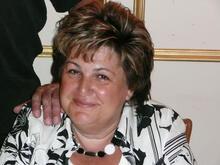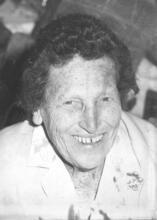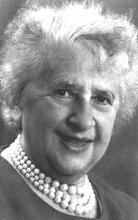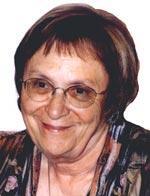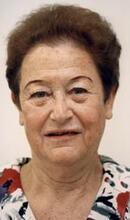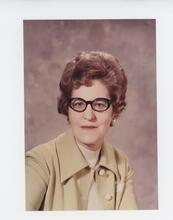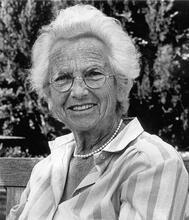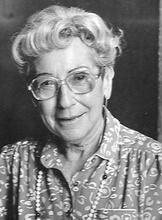Raissa L’vovna Berg
Born in St. Petersburg, Raissa Berg began studying genetics in 1930. She continued this work at several universities and institutes in the 1930s and 40s and worked with many eminent researchers. With the rise of anti-genetics Soviet policy, Berg was first demoted and then dismissed in 1948. Nevertheless, she kept writing and continued her research at home, eventually discovering “correlative Pleiades: in plants. She reentered academia in 1954 with a professorship appointment, which contributed significantly to the reestablishment of the scientific field of genetics in Russia, but she was forced into retirement once again in 1968. After emigrating to the United States in 1974, Berg taught at universities and traveled for lectures and genetic congresses, remaining active until her death in 2006.
Raissa Berg was an outstanding biologist and geneticist of international repute, a defender of human rights in the Soviet Union, an abstract painter and a writer.
Early Life
Raissa Berg was born in St. Petersburg on March 27, 1913. Her father, Lev Semenovitch Berg, a professor at the Petersburg University, was an eminent Russian geographer, zoologist and evolutionist. Lev Berg and his first wife Polina, Raissa’s mother, were natives of Bendery, a small provincial city in Bessarabia, within the Jewish Pale of Settlement. In order to enroll in the Moscow University Lev Semenovich Berg, like his relatives who had received a medical education, had to convert to Christianity. He chose the Lutheran faith. Raissa was six weeks old when her parents separated. Her father took Raissa away, together with her older brother Sim (Simon Berg, b. 1911). As Raissa later recorded, her mother sued, but the Russian Orthodox Church, which judged such cases at that time, decided in favor of her father, a Christian (Berg 1988, 3–5). Shortly thereafter Simon and Raissa were also baptized into the Lutheran faith. They were raised by their father and paternal grandmother, Klara L’vovna Berg and, after L. S. Berg’s second marriage in 1923, by their stepmother, Maria Mikhailovna Ivanova.
Raissa Berg and her brother were sent to the German Lutheran school in St. Petersburg, from which she graduated in 1929. In 1930 she entered Leningrad University. Berg began her research in the Genetics Department under the supervision of the eminent American geneticist Hermann Muller, who spent four years in Soviet Russia (from 1933 to 1937) working in N. Vavilov’s Institute of Genetics in Leningrad (formerly St. Petersburg).
Career in Soviet Russia
In 1935 Berg received her diploma in genetics (equivalent to an M.S.) and began post-graduate studies in genetics at Leningrad University’s Genetics Department. In 1939 she became a “candidate of sciences” (approximately equivalent to a Ph.D.), having written a dissertation on “Differences between wild and laboratory populations of Drosophila melanogaster: a hypothesis of genetic correlations.” The same year she left Leningrad for Moscow, where she started to work at the A. N. Severtsov Institute of Evolutionary Morphology headed by I. I. Schmalhausen, one of the leaders of Russian theoretical biology in the 1940s. In October 1941 the institute was evacuated to Kazakhstan. In 1942 Raissa Berg returned to Moscow and settled down to work on her doctoral dissertation on “Species as an Evolving System.”
In 1945 Berg married geneticist Valentin Sergeevich Kirpichnikov (1908–1991). They had two daughters, Liza and Masha (Elizaveta Kirpichnikova, born in 1947, and Maria Kirpichnikova, born in 1948).
From 1944 to 1946 Berg worked as senior researcher at Schmalhausen’s Institute in Moscow. The laboratory where she studied the mutational process in wild populations of Drosophila was affiliated with the Moscow University’s Department of Darwinism, also headed by Schmalhausen.
During the 1940s genetics in USSR entered a dark age: Soviet agronomist Trofim Lysenko, patronized by the highest Soviet authorities and directly supported by Joseph Stalin, came to power and aggressively furthered his views on inheritance, criticizing Mendelian genetics as a “bourgeois science.” His political success launched an oppressive ideological campaign against geneticists, who were driven out of the major research institutions. As Raissa Berg recollected, by 1946 “there was only one geneticist at Moscow University’s Department of Darwinism and one geneticist at the Institute of Evolutionary Morphology, and I was both of them” (Berg, 1988, 125). Dismissed from the Institute of Evolutionary Morphology in 1946, Berg moved to Leningrad, where her husband—now demobilized from the army—headed the laboratory of genetics and fish selection at the Leningrad Institute of Fish Breeding. In Leningrad Berg managed to find only a modest position as half-time assistant professor at the Herzen Pedagogical Institute where she lectured on Darwinism until 1948.
In August 1948 the infamous VASKhNIL session marked the beginning of a wide ideological campaign against genetics and geneticists for the complete domination of Michurinist biology. All over the Soviet empire geneticists were dismissed from the academic institutions and university departments. Raissa Berg was among them, but she continued to work, publishing several papers on L. S. Berg’s geographical explorations and a book on her father’s Siberian and Asian expeditions. Working at her country house near Leningrad she carried out the biometric analysis of vegetative and generative parts of various plants and discovered the so-called “correlative pleiades.” She found that the size of certain parts of an organism did not depend on the size of the other parts or on the magnitude of the organism as a whole, and that the plant’s characteristics fluctuated independently of one another. This research resulted in a fundamental work on the ways and factors of plant evolution summarized in her doctoral dissertation (officially defended only in 1964).
In 1954 Berg was appointed assistant professor in the Leningrad University Department of Darwinism, where she lectured on Darwinism and Evolutionary Genetics and continued to study the correlative pleiades in plants. In 1963 Berg was invited to head the newly created laboratory of population genetics at the Institute of Cytology and Genetics in Novosibirsk Akademgorodok (Academy City). There she coordinated the Drosophila genetics research and resumed her studies of phenotypic and genotypic structures of wild populations of Drosophila. Besides Drosophila research, Raissa Berg initiated the studies of the population genetics of human hereditary diseases. Her work contributed significantly to the reestablishment of the scientific field of genetics in Russia.
At that time of liberalization of the Russian society under Nikita Khrushchev, the Novosibirsk Academy City enjoyed comparative freedom due to its peripheral geographical and institutional location. Raissa Berg was at the center of “non-conformist” cultural and civic life in Novosibirsk. Her apartment was a well-known gathering place for dissenter writers, poets and painters (A. Galich, V. Delauney and others). In 1967 she signed the famous “Letter of Forty-Six” which expressed a mass protest against governmental violations of law in the Soviet Union. In 1968, with the end of the short liberal period in Soviet Russia (ottepel’), she was forced to retire from the Institute, whereupon she returned to Leningrad.
Later Life
In 1974 she decided to emigrate to the United States. From 1975 to 1981 she worked at the University of Wisconsin in Madison. From 1984 to 1994 she was affiliated with the George Washington University in Saint Louis, Missouri, as a visiting professor. During her stay in the United States, she traveled widely, lecturing and participating in genetic congresses. In 1994 Raissa Berg moved to Paris, where her older daughter lived, and stayed active, full of plans for the future.
Raisa Berg died on March 1, 2006, in Paris.
Selected Works by Raissa Berg
“The relative frequency of mutations in different chromosomes of Drosophila melanogaster.” Genetics 22 (1937): 225–240; 241–248.
“On the relative roles of stabilization and redifferentiation of the gene in the evolution of heredity substance” Genetics 22 (1937): 402–405.
Heredity and hereditary diseases in Man (Russian), with S. N. Davidenkov. Leningrad: 1971.
“Mutability changes in Drosophila melanogaster populations of Europe, Asia and North America and probable mutability changes in human populations of the USSR” Japan J. Genet. 57 (1982): 171–183.
Hot Wind (Russian). New York: 1983.
Acquired traits. Memoirs of a geneticist from the Soviet Union. New York: 1988.
Genetics and Evolution (Russian). Novosibirsk: 1993.
Berg, Raissa L. Interview with author. Paris, October 2002.
Berg, Raisa L'vovna. Sukhovei: vospominaniia genetika. New York: Chalidze Publications, 1980.
Conner, Jeffrey K., and Russell Lande. "Raissa L. Berg's Contributions to the Study of Phenotypic Integration, with a Professional Biographical Sketch." Philosophical Transactions: Biological Sciences 369, no. 1649 (2014): 1-4.
Glass, Bentley. "Foreword." The Quarterly Review of Biology 65, no. 4 (1990): 413-21.
Kolosova, L. D., Maletckii S. I., Zakharov, I. K. “Raissa L’vovna Berg: on the occasion of the ninetieth anniversary of her birth” (Russian). Bulletin VOGIS 24–25 (2003).
On the history of genetics in Russia, see:
Adams, M., ed. The Wellborn Science: Eugenics in Germany, France, Brazil, and Russia. New York: 1990.
Graham, L. Science, Philosophy and Human Behavior in the Soviet Union. New York: 1987.
Graham, Loren. "Epigenetics and Russia." Proceedings of the American Philosophical Society 160, no. 3 (2016): 266-71.
Joravsky, D. The Lysenko Affair. Chicago: 1970.
Krementsov, N. Stalinist Science. Princeton: 1997.
Krementsov, Nikolai. "A "Second Front" in Soviet Genetics: The International Dimension of the Lysenko Controversy, 1944-1947." Journal of the History of Biology 29, no. 2 (1996): 229-50.
Medvedev Z. The Rise and Fall of T. D. Lysenko. New York: 1969.
Soyfer, V. N. Lysenko and the tragedy of Soviet science. Translated from the Russian by L. Gruliow and R. Gruliow. New Brunswick: 1994.


